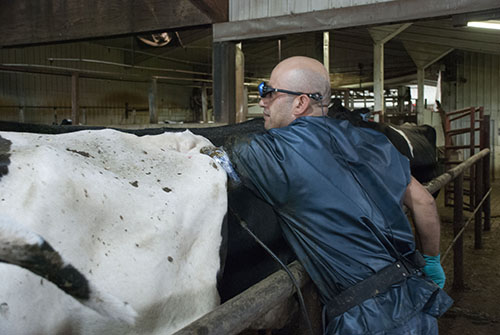
"Our goal is to have herds reach a pregnancy rate of 25 percent," said James Ferguson, University of Pennsylvania School of Veterinary Medicine, during his presentation at the Purina Leading Dairy Producers Conference. "When you're above a 20 to 25 percent pregnancy rate, losses per unit of pregnancy are very low."
Ferguson explained that under a 20 percent pregnancy rate, you can't maintain herd size. You will either need to purchase animals or extend calving interval dramatically (by 20 to 25 percent, depending on calf mortality, culling rate, age at first calving, and so forth) to sustain herd size.
A pregnancy rate above 20 percent produces more heifers, which means you have extra animals to sell or to grow your herd internally. "We look at that as a positive economic factor within the herd," he said.
To achieve a 25 percent pregnancy rate, you need a conception rate of 40 percent and a heat detection rate of 60 percent. "Pregnancy rate is a function of these two variables," he said. "It is the proportion of cows that get pregnant every 21 days."
The average conception rate on Pennsylvania dairies is 33 percent, and pregnancy rate is at 18 percent. These numbers have improved, according to Ferguson, but herds are still losing money.
What can be done to elevate pregnancy rate? Ferguson focused on some of the factors that play a role in getting cows bred and in turn influence the number of cows that leave the herd for reproductive reasons. These include:
Management factors - Decisions about heat detection, insemination, voluntary waiting period, and so forth all affect pregnancy rate.
Bull and inseminator factors - There is the semen fertility to consider, of course, but also critical is the skill level of the person doing the inseminating. Ferguson said, "When we see conception rates below 30 percent, it's probably not a problem with the cow but rather with the technician."
Cow - "When repro is bad, cows get the blame," Ferguson stated. He explained that every time a cow has a problem at calving - metritis, displaced abomasum, ketosis, lameness - her conception rate is lowered.
Environmental - "Our major environmental factor is heat stress," noted Ferguson. "But, if farms are doing a good job cooling cows, we don't see seasonal affects on conception rate."
Normally, 10 to 15 percent of cows, or one third of all culls, leave the herd for reproductive reasons. Ferguson said that there will always be some problem cows, but if you strive for a 25 percent pregnancy rate, you can keep more cows in the herd working for you.
 The author is an associate editor and covers animal health, dairy housing and equipment, and nutrient management. She grew up on a dairy farm near Plymouth, Wis., and previously served as a University of Wisconsin agricultural extension agent. She received a master's degree from North Carolina State University and a bachelor's from University of Wisconsin-Madison.
The author is an associate editor and covers animal health, dairy housing and equipment, and nutrient management. She grew up on a dairy farm near Plymouth, Wis., and previously served as a University of Wisconsin agricultural extension agent. She received a master's degree from North Carolina State University and a bachelor's from University of Wisconsin-Madison.








